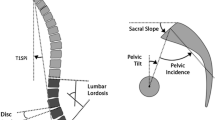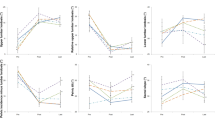Abstract
Study Design
Retrospective cohort study.
Objective
To determine if severe sagittal malalignment (SM) patients without fixed deformities require a three-column osteotomy (3CO) to achieve favorable clinical and radiographic outcomes.
Summary of Background Data
3CO performed for severe SM has significantly increased in the last 15 years. Not all severe SM patients require a 3CO.
Methods
Severe SM patients (sagittal vertical axis [SVA] >10 cm) who underwent deformity correction between 2002 and 2011. Patients with <33% change in their lumbar lordosis (LL) on a preoperative supine radiograph were classified as stiff deformities, whereas those with ≥33% change were categorized as flexible deformities. The clinical/radiographic outcomes were assessed at minimum two years postoperatively.
Results
Seventy patients met the inclusion criteria, 35 patients with flexible and 35 with stiff deformities. Eighteen flexible-deformity patients underwent a 3CO versus 22 stiff-deformity patients. The remaining patients in each group underwent spinal realignment without a 3CO. The flexible-deformity patients not undergoing a 3CO had overall improvement in all sagittal radiographic parameters. Preoperative LL (22°), LL–pelvic incidence (PI) mismatch (43), SVA (17 cm), and pelvic tilt (PT, 34°) improved to 46°, 18, 6 cm, and 26°, respectively, p < .05. Flexible-deformity patients who underwent a 3CO also had overall improvement in all radiographic parameters. Preoperative LL (8.5°), LL-PI mismatch (47), SVA (19 cm), and PT (37°) improved to 39°, 15, 7 cm, and 24°, respectively (p < .05). Stiff-deformity patients who underwent a 3CO had statistically significant improvement in all radiographic parameters. However, stiff-deformity patients who did not undergo a 3CO had suboptimal improvement in all radiographic parameters, except for SVA (14 cm-9 cm, p < .05). Flexible patients who did not undergo a 3CO had statistical improvement in the SRS domains of function and self-mage as well as in their ODI scores (p < .05).
Conclusion
Severe SM that is flexible can be corrected without a 3CO without compromising clinical and radiographic outcomes.
Level of Evidence
Level III.
Similar content being viewed by others
References
Booth KC, Bridwell KH, Lenke LG, et al. Complications and predictive factors for the successful treatment of flatback deformity (fixed sagittal imbalance). Spine (Phila Pa 1976) 1999;24: 1712–20.
Glassman SD, Berven S, Bridwell K, et al. Correlation of radiographic parameters and clinical symptoms in adult scoliosis. Spine (Phila Pa 1976) 2005;30:682–8.
Glassman SD, Bridwell K, Dimar JR, et al. The impact of positive sagittal balance in adult spinal deformity. Spine (Phila Pa 1976) 2005;30:2024–9.
Diebo B, Liu S, Lafage V, Schwab F. Osteotomies in the treatment of spinal deformities: indications, classification, and surgical planning. Eur J Orthop Surg Traumatol 2014;24(suppl 1): S11–20.
Auerbach JD, Lenke LG, Bridwell KH, et al. Major complications and comparison between 3-column osteotomy techniques in 105 consecutive spinal deformity procedures. Spine (Phila Pa 1976) 2012;37:1198–210.
Kim SS, Cho BC, Kim JH, et al. Complications of posterior vertebral resection for spinal deformity. Asian Spine J 2012;6:257–65.
Lenke LG, Newton PO, Sucato DJ, et al. Complications after 147 consecutive vertebral column resections for severe pediatric spinal deformity: a multicenter analysis. Spine (Phila Pa 1976) 2013;38: 119–32.
Lenke LG, O’Leary PT, Bridwell KH, et al. Posterior vertebral column resection for severe pediatric deformity: minimum two-year follow-up of thirty-five consecutive patients. Spine (Phila Pa 1976) 2009;34:2213–21.
Suk SI, Kim JH, Kim WJ, et al. Posterior vertebral column resection for severe spinal deformities. Spine (Phila Pa 1976) 2002;27: 2374–82.
Bridwell KH. Decision making regarding Smith-Petersen vs. pedicle subtraction osteotomy vs. vertebral column resection for spinal deformity. Spine (Phila Pa 1976) 2006;31(19 Suppl): S171–8.
Smith-Petersen MN, Larson CB, Aufranc OE. Osteotomy of the spine for correction of flexion deformity in rheumatoid arthritis. Clin Orthop Relat Res 1969;66:6–9.
McMaster MJ. A technique for lumbar spinal osteotomy in ankylosing spondylitis. J Bone Joint Surg Br 1985;67:204–10.
Kostuik JP, Maurais GR, Richardson WJ, Okajima Y. Combined single stage anterior and posterior osteotomy for correction of iatrogenic lumbar kyphosis. Spine (Phila Pa 1976) 1988;13:257–66.
Hehne HJ, Zielke K, Bohm H. Polysegmental lumbar osteotomies and transpedicled fixation for correction of long-curved kyphotic deformities in ankylosing spondylitis: report on 177 cases. Clin Orthop 1990;258:49–55.
Lagrone MO, Bradford DS, Moe JH, et al. Treatment of symptomatic flatback after spinal fusion. J Bone Joint Surg Am 1988;70: 569–80.
Voos K, Boachie-Adjei O, Rawlins BA. Multiple vertebral osteotomies in the treatment of rigid adult spine deformities. Spine 2001;26:526–33.
Thomasen E. Vertebral osteotomy for correction of kyphosis in ankylosing spondylitis. Clin Orthop 1985;194:142–52.
Bridwell KH, Lewis SJ, Lenke LG, et al. Pedicle subtraction osteotomy for the treatment of fixed sagittal imbalance. J Bone Joint Surg Am 2003;85:454–63.
Berven SH, Deviren V, Smith JA, et al. Management of fixed sagittal plane deformity: results of the transpedicular wedge resection osteotomy. Spine 2001;26:2036–43.
Carreon LY, Puno RM, Dimar 2nd JR, et al. Perioperative complications of posterior lumbar decompression and arthrodesis in older adults. J Bone Joint Surg Am 2003;85:2089–92.
Cho KJ, Bridwell KH, Lenke LG, et al. Comparison of Smith-Petersen versus pedicle subtraction osteotomy for the correction of fixed sagittal imbalance. Spine (Phila Pa 1976) 2005;30: 2030–7.
Daubs MD, Lenke LG, Cheh G, et al. Adult spinal deformity surgery: complications and outcomes in patients over age 60. Spine (Phila Pa 1976) 2007;32:2238–44.
Glassman SD, Hamill CL, Bridwell KH, et al. The impact of perioperative complications on clinical outcome in adult deformity surgery. Spine (Phila Pa 1976) 2007;32:2764–70.
Bianco K, Norton R, Schwab F, et al. International Spine Study Group. Complications and intercenter variability of three-column osteotomies for spinal deformity surgery: a retrospective review of 423 patients. Neurosurg Focus 2014;36:E18.
Saleh A, Thirukumaran C, Mesfin A, Molinari RW. Complications and readmission after lumbar spine surgery in elderly patients: an analysis of 2,320 patients. Spine J 2017;17:1106–12.
Sansur CA, Smith JS, Coe JD, et al. Scoliosis Research Society morbidity and mortality of adult scoliosis surgery. Spine (Phila Pa 1976) 2011;36:E593–7.
Smith JS, Sansur CA, Donaldson 3rd WF, et al. Short-term morbidity and mortality associated with correction of thoracolumbar fixed sagittal plane deformity: a report from the Scoliosis Research Society Morbidity and Mortality Committee. Spine (Phila Pa 1976) 2011;36: 958–64.
Harimaya K, Lenke LG, Mishiro T, et al. Increasing lumbar lordosis of adult spinal deformity patients via intraoperative prone positioning. Spine (Phila Pa 1976) 2009;34:2406–12.
Author information
Authors and Affiliations
Corresponding author
Additional information
Author disclosures: IOK (none), LGL (none), KHB (none), RT (none), MPK (none), PAS (none), DBB (none), AE (none), OA (none), RL (none), LK (none), KB (none), JG (none).
IRB Approval Statement: This study was approved by the Institutional Review Board (IRB) of the Washington University School of Medicine, St. Louis, MO.
All surgeries and research for this study were performed at the Department of Orthopedic Surgery, Washington University School of Medicine in St. Louis, MO.
Rights and permissions
About this article
Cite this article
Karikari, I.O., Lenke, L.G., Bridwell, K.H. et al. Key Role of Preoperative Recumbent Films in the Treatment of Severe Sagittal Malalignment. Spine Deform 6, 568–575 (2018). https://doi.org/10.1016/j.jspd.2018.02.009
Received:
Revised:
Accepted:
Published:
Issue Date:
DOI: https://doi.org/10.1016/j.jspd.2018.02.009




